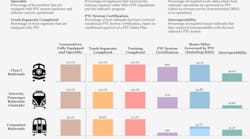Commuter Rail Coalition sounds warning regarding possible supply chain disruption surrounding PTC components; cost of ongoing upgrades
The Commuter Rail Coalition (CRC) issued a response to the release of railroads self-reported progress toward implementation of Positive Train Control (PTC) for the fourth quarter of 2019 by the Federal Railroad Administration (FRA) last week.
Overall, commuter railroads have reached nearly 55 percent of the required total route miles now governed by PTC, while six of the eight railroads FRA labeled “at risk” of noncompliance with the mandate carry passenger traffic.
From CRC:
What is starkly missing from media coverage and other commentary on that report is an in-depth review of the challenges that stand in the way of passenger railroads meeting the Dec. 31, 2020, PTC deadline. These are challenges that have repeatedly been documented in assessments by the Governmental Accounting Office (GOA), and which neither the FRA nor – at this juncture – more financial resources can overcome.
Chief among these challenges may well be a dearth of vendor resources. But following closely is a new concern that the supply chain out of Asia is vulnerable to interruption because of the coronavirus (COVID-19).
Just seven months ago, GAO’s Director for Physical Infrastructure Susan Fleming testified before the Senate Commerce Committee that “the limited supply of vendors and high demand for services as railroads work simultaneously to implement PTC…continue to pose problems.” More specifically, “vendor and software issues remain major or moderate challenges for PTC implementation,” and the approaching 2020 deadline leaves little time to resolve these issues. Case in point: one Commuter Rail Coalition member reports a vendor having already logged its 80th software revision.
The rapid spread of COVID-19 through Asia also threatens to have an impact on a railroad’s implementation timeline. Suppliers have preemptively begun notifying customers of the risk to their supply chains for components being manufactured in Asia, where the outbreak is most severe.
And even after a railroad’s PTC system has been certified, there will be scant opportunity to shift focus or resources to other safety or operational priorities. A CRC member railroad operating in PTC has already found it necessary to upgrade hardware components to maintain interoperability with its host railroad. Having spent in excess of $4 billion to install and implement the unfunded mandate that is PTC, the nation’s commuter railroads contracting for ongoing operations and maintenance of their PTC systems are now receiving bids in the range of five to 10 percent of their annual operating budget.
The CRC calls on Congress for assurance that the appropriate grant programs allow for these ongoing, significant expenses.
According to CRC Chair Jim Derwinski (Metra), “Because PTC systems will need continuous updates and modifications, in addition to normal component replacements, it is important that Congress clarify the law and regulations to ensure PTC ongoing annual capital replacement costs for components and software, and the associated costs of installing such systems, are an eligible reimbursable expense under the federal formula and discretionary grant programs.”




